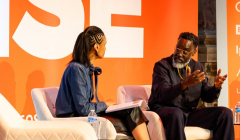
Create for consumers, don’t market at them
Speaking at the Creative Equals Rise conference, Ije Nwokorie, Chief Brand Officer at Dr Martens urged marketers to adopt a product-led mindset

How can brands stand out in a fragmented media landscape during such an iconic advertising moment

This Sunday Philadelphia Eagles and Kansas City Chiefs will go head to head in the 57th annual Super Bowl. Yet the spectacular is about more than just the game. Each year the event draws in millions of viewers from around the world. Viewers who tune in to not only watch the match, but drink in the whole event, the halftime show and most importantly for the creative industry: the advertising.
The Super Bowl is one of the few times of year that all eyes are on the adverts, therefore brands are afforded a unique opportunity to be an integral part of the whole experience.
In past years big-ticket brands have gravitated toward humour and the power of celebrity, but where Super Bowl spots don’t come cheap, smaller brands have had to think of creative ways to get involved and grab attention. In 2021 Reddit’s 5-second spot which was made up of a block of text made audiences pause and read. The brand successfully used intrigue to make up for a tighter budget. Other brands might look to get involved in the event outside of the traditional linear ad slots with TikTok challenges or Super Bowl-themed social.
In a fragmented media landscape and with an event as iconic as the Super Bowl thinking creatively to stand out amongst the crowd isn’t easy. Ahead of Sunday’s event we asked industry leaders, have the ingredients of a successful Super Bowl spot changed in 2023?

The Super Bowl is a huge advertising opportunity and typically garners the highest viewership linear TV has to offer. To capitalise on this reach and cater to a digitally-diverse audience, this year expect to see more brand’s creative looking to resonate with an increasingly influential, younger demographic.
With Gen-Z’s set to have an estimated combined spending power of $3.0 trillion by 2030, brands are understandably focusing efforts on unlocking this audience. They will do this by leveraging social platforms, including TikTok and Twitch, but equally by extending the lifespan of their Super Bowl ad campaigns - teasing the spot through YouTube or other social platforms before TVC airing on the main event.
In this landscape, originality is the currency for brands looking to capitalise on this flagship cultural moment. About a quarter of the Super Bowl audience thinks ads are the most important aspect of the event. However, cut-through is hard to come by in a saturated market, meaning Super Bowl ads need to continue to develop and innovate their storytelling, with increasing emphasis placed on production value and celebrity power to land marquee spots.
Though many of the traditional ingredients to a successful Super Bowl commercial will remain the same as ever: humour, cultural relevance, reference to pop-culture, innovation and celebrity presence. The way in which brands are now unifying their Super Bowl creative strategy across linear and digital is indicative of the need to resonate more clearly with a varied, digitally-savvy consumer base.

The Super Bowl is advertising’s global stage, and when it airs this Sunday, the whole world will scrutinise every ad declaring which hit the creative mark and which ones fall short. But do the rules change just because more eyeballs are watching?
Super Bowl ads are still ads. Commercial creativity in a high-reach moment to drive mass awareness and - hopefully - brand salience. The objective is still effectiveness. The most celebrated Super Bowl ads of any year have deployed the same tactics we see in the most celebrated ads, full stop.
Celebrities tap into cultural references, while animals, babies or music pull on our emotional strings and knowing, self-referential nods drive brand warmth. As with all great campaigns, the best Super Bowl work starts with a product or brand truth but, because it's the Super Bowl, supersizes that truth in a simple yet arresting way.
The world is challenging right now, so as advertising enjoys the spotlight again, we should endeavour to do what advertising does best: entertain. This year, with some added optimism and joy to energise audiences, and maybe a smattering of nostalgia to offer some moments of pure escapism. This Sunday, we should look beyond the eyeballs to lift people's hearts.

I’d argue that very few Super Bowl ads are successful. In today’s world, a creative spot is no good if it doesn’t last beyond those 30 seconds. They’ve become “one-and-done” events. Blogs might pour over their favourites. But, to the average American, they’re just flashier versions of what they see and ignore every day.
Audiences are numb to it because most brands follow the same playbook year-in, year-out. Building their ads around one (or all three) of the following:
1. Surprise celebrity appearances
1. Nostalgia
2. Self-deprecation (with the help of a late-night talk show writer)
Everyone looks and sounds the same. It’s like trying to remember what one of the 73,000 fans inside State Farm Stadium was wearing.
In 2023, it doesn’t seem like much will change. Brands are following that playbook to a tee. Bryan Cranston and Aaron Paul are reprising their Breaking Bad characters for PopCorners. Alicia Silverstone returns as Cher for Rakuten’s Clueless-themed ad.
It’s fun, sure, but empty. Audiences will remember the stars, not the brands. If a brand wants to be truly successful, they need to stop focusing on outdoing their peers. They need to say something that lives and lasts with real people.

As the Super Bowl continues to evolve, brands must too. A big-moment TV spot is no longer something that can be wholly dependent on, there must be a broader, strategic approach providing audiences with an all-encompassing experience. Gone are the days when ads only serve one medium. Viewers are craving sensory experiences through ads that feed and fulfil all their senses- especially sound, whilst still finding innovative ways of weaving in pop culture. This can be seen with Zoe Kravitz's viral ASMR Super Bowl ad in 2019 or this year’s Uber One Super Bowl ad with Diddy, which remixes throwback hits, giving fans a taste of nostalgia - blurring the lines between fantasy and reality whilst using the power of celebrity to tap into pop culture. Brands need to re-envision how they interact with consumers as their behaviours change and seamlessly create culturally relevant moments that resonate with all demographics. It’s about finding the right balance and knowing how much the audience is ready to receive. It’s not that the ingredients to a successful Super Bowl ad has changed, it’s that there are more ingredients on the list to consider to deliver a memorable Super Bowl ad.

The Super Bowl, the only time outside Christmas that ads still form a major part of non-ad folks conversation. The power of the advertising spot during the Super Bowl simply isn’t in question, the decision of our client Pepsi to end its decade long sponsorship of the halftime show to focus on ad placement is further testament to this. That said, the most fundamental KPI of any Super Bowl brief (or the vast majority of briefs for that matter), whether buying a spot during the main broadcast, or looking to align via other medias, is to standout. You simply cannot spend this amount of your annual budget (currently upwards of $7 million for a 30 second spot on Fox) and be wallpaper. Be it a floating logo or the most celeb packed 60” with a bigger production budget than Avatar 2, you and your brand must be noticed, and creative originality is still the single best way to achieve that irrespective of the year or media.

Here are 4 key ingredients to a successful Super Bowl spot in 2023:
· Culture
· Key Moments
· Inclusivity
· Getting weird
These ideas come from a quantitative survey Sid Lee ran last year with the Angus Reid Group of 1,000 Gen-Z’ers aged 18 to 25. Essentially, the next generation relates to sports in a whole new way. They prefer bite-sized highlights to watching entire games. They’re interested in spots that are culturally relevant (whether that be a nod to gaming, music, etc.), inclusive, and, above all, funny. 77% of Gen Z’s said that the ads they talk about with their friends are the ones that made them laugh. And if you want to make Gen Z laugh, you gotta get a bit weird.
Looks like you need to create a Creativebrief account to perform this action.
Create account Sign inLooks like you need to create a Creativebrief account to perform this action.
Create account Sign in